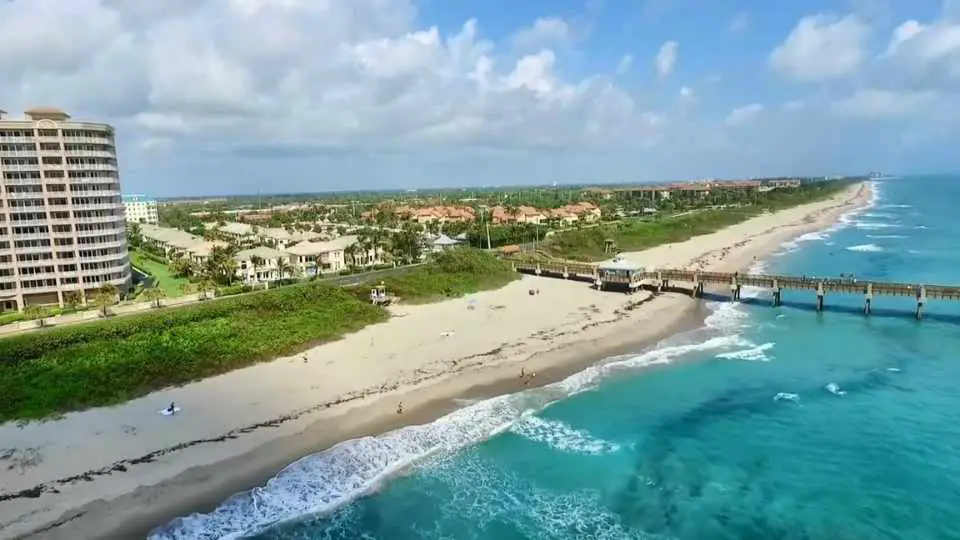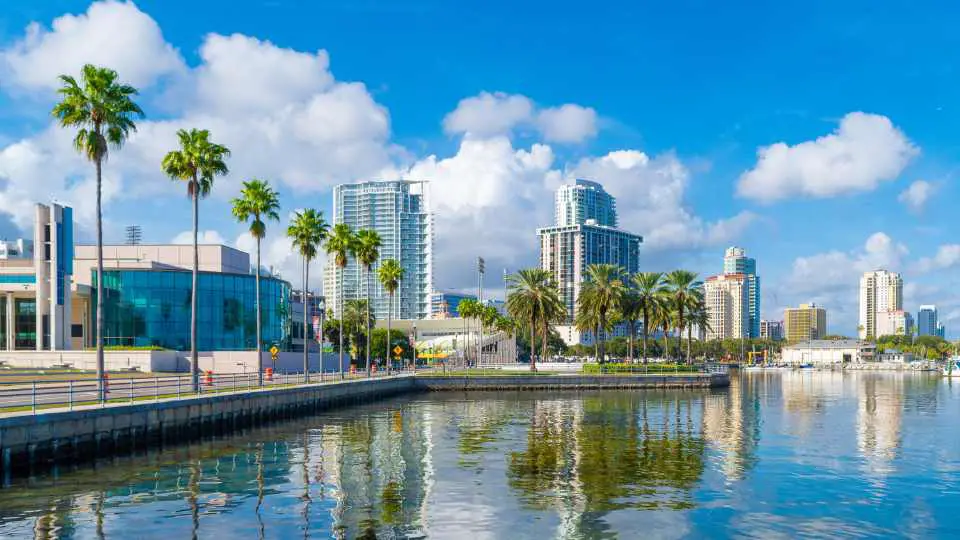What is Living in Florida Really Like: Unveiling the Sunshine State Lifestyle
Living in Florida offers a unique experience influenced by a variety of factors, including climate, economic opportunities, and lifestyle perks. Known as the Sunshine State, Florida is renowned for its year-round warm weather and extensive coastline, attracting those who favor a subtropical climate.
It’s home to a diversity of cities, from the bustling metropolitan Miami to the laid-back, culturally-rich Tampa Bay area. The state’s natural beauty, with its sprawling beaches, numerous parks, and varied wildlife, is a significant draw for both residents and tourists.
Economically, Florida’s lack of a state income tax can be financially beneficial for residents, making it an appealing destination for individuals looking to maximize their earnings. This financial incentive, coupled with a growing job market in sectors such as tourism, agriculture, and aerospace, contributes to Florida’s reputation as a state with a robust economy.
While cost of living can vary greatly depending on the specific region, some areas offer affordable living options without compromising on quality of life.
Life in Florida can be as leisurely or as dynamic as one chooses, with options ranging from participating in local community events and festivals to engaging in a myriad of outdoor activities such as boating, fishing, and golfing. Florida’s lifestyle is reflective of its diverse population that values community, the outdoors, and a blend of traditional and contemporary living.
Climate and Weather
Florida is well-known for its warm climate and the abundance of sunshine, making it an attractive destination for those who prefer a warmer living environment. However, the state’s weather patterns also include high humidity and a pronounced hurricane season.
Sunshine and Warmth
Florida lives up to its nickname, the Sunshine State, offering residents an abundance of sunny days and mild temperatures, especially during the winter months. In southern parts of the state, winter temperatures can often stay around 68°F (20°C). The temperate weather allows for a host of outdoor activities year-round.
Heat and Humidity
For approximately eight months of the year, Florida experiences high heat coupled with significant humidity, which can be particularly intense from late March through September. During the summer, temperatures can soar as high as 90°F (32°C) and the air becomes quite moist, which may be uncomfortable for some individuals.
Hurricanes and Natural Disasters
Florida’s location makes it prone to hurricanes and tropical storms, particularly from June to November. These powerful storms can cause extensive damage and require residents to be prepared each season. Apart from hurricanes, Florida can also experience other natural disasters such as tornadoes and, though less frequently, wildfires, due to its warm and humid climate.

Geographic Diversity
Florida’s geographic diversity ranges from stunning beaches to unique wetland ecosystems, coupled with vibrant urban centers that vary markedly between the north and south, as well as along the Atlantic and Gulf coasts.
Beaches and Coastlines
Florida’s beaches are renowned for their soft sand and crystal-clear waters, attracting tourists and residents alike. South Florida hosts the iconic Miami Beach, known for its lively atmosphere and Art Deco Historic District. The Gulf Coast offers more tranquil options, such as the white quartz sands of Siesta Key near Sarasota. Florida’s extensive coastline spans over 1,350 miles, ensuring a beach experience to suit every preference.
Everglades and State Parks
The Everglades, a UNESCO World Heritage site, represents one of the most distinctive natural features of Florida. This vast wetland is home to a myriad of wildlife species, maintaining its allure as both a national park and a draw for ecotourism.
Beyond the Everglades, the state boasts over 175 state parks, preserving diverse ecosystems. The terrain varies from the submerged aquatic preserves to the dry uplands and forests of Central and North Florida.
Urban Metro Areas
Florida’s urban areas each have distinct personalities and are connected to their geographical settings. Miami serves as a cultural and economic hub with a decidedly international flair in palimpsest with its coastal geography. Orlando, positioned in Central Florida, is world-famous for its theme parks, including Walt Disney World Resort, while Jacksonville, the largest city by area in the contiguous United States, anchors the northeastern part of the state with a growing urban park system. Tampa on the west coast balances its business district with historic neighborhoods and a strong cultural community.

Cost of Living
Living in Florida offers a mixed financial landscape where residents save on state income tax but may face various costs depending on their location and lifestyle.
Housing Market Trends
Florida’s housing market varies by region, but the state has experienced a general upward trend in real estate prices. In 2024, the state law has set a minimum wage to $12 per hour, influencing the cost of living and housing affordability. The median home price in the state reflects regional popularity and economic factors.
Florida ranks as the 14th best state to live in the United States, yet housing costs can be 3.1% higher than the U.S. average. Florida’s diverse real estate market might impact one’s ability to find affordable housing, making it essential to consider local housing market trends.
State Income Tax Benefits
One of the most significant financial advantages of living in Florida is the absence of state income tax. This policy means that individuals do not pay state tax on their earned income, which can translate into substantial savings compared to residents in states with an average income tax rate. For instance, an income of $50,000 would save an individual approximately $2,500 annually if they lived in a state with an average tax rate of 5%.
Expenses and Affordability
The cost of living in Florida is approximately 1.19 times higher than the national average, with expenses such as food, childcare, transportation, healthcare, and taxes contributing to the daily financial burden. Despite medical care and education expenses aligning with national averages, these can vary widely at the local level.
Although Florida residents benefit from no state income tax, the overall high cost of living can offset such savings depending on the individual’s specific circumstances and lifestyle choices.

Economy and Employment
Florida’s economy is robust with diverse job opportunities, a generally low unemployment rate, and a significant impact from the retiree population. These factors create a dynamic environment, particularly for those considering moving to the state.
Job Market Analysis
The job market in Florida offers a varied landscape, with a mix of industries driving employment. Some of the key sectors include tourism, agriculture, international trade, and aerospace. The influx of new residents and a growing population support a continuous demand for jobs. As of the last quarter of 2023, Florida’s job growth was reportedly outpacing the national average, suggesting a welcoming environment for job seekers.
Unemployment Trends
As of November 2023, Florida’s unemployment rate stood at an impressive 2.9%, which was lower than the U.S. overall unemployment rate. This reflects a strong job market that is able to accommodate job seekers effectively. It’s particularly attractive for individuals moving to Florida, as the prospect of finding employment is comparably better than in many other states.
Unemployment Rate in Florida (as of November 2023): 2.9%
Retiree Economy
Retirees contribute significantly to Florida’s economy. The state’s pleasant climate, favorable tax laws, and well-developed retiree infrastructure make it a preferred destination for retirees. This demographic not only boosts the housing market but also underpins a considerable service industry tailored to their needs. As retirees often have disposable income, they help sustain local businesses, from healthcare to leisure and entertainment.
Key Factors Attracting Retirees to Florida:
- Warm climate
- Favorable tax environment
- Established retiree communities
Florida’s economy and employment outlook showcase the state’s capacity to support a growing workforce and retiree population. A strong job market coupled with a lower-than-average unemployment rate positions Florida as an attractive destination for both work and retirement.

Lifestyle and Recreation
Living in Florida offers an extensive array of entertainment options and recreational activities, catering to a diversity of interests. Whether one enjoys vibrant nightlife, water-based adventures, or cultural exchanges, Florida’s lifestyle is replete with opportunities to explore and indulge.
Entertainment and Nightlife
Florida is home to a thriving entertainment scene, with Orlando and Miami leading the charge. Orlando is world-renowned for Walt Disney World and the Universal Orlando Resort, parks that enchant visitors with a mix of thrilling rides and immersive themed experiences. Miami, on the other hand, boasts a vibrant nightlife with a plethora of clubs, bars, and live music venues that cater to every taste.
- Notable Theme Parks:
- Walt Disney World
- Universal Orlando
- SeaWorld Orlando
- Nightlife Hotspots:
- South Beach (Miami)
- Downtown Orlando
- Ybor City (Tampa)
- Las Olas / Downtown Fort Lauderdale
Outdoor and Water Activities
Florida’s geography makes it a paradise for outdoor and water recreation enthusiasts. Its long coastline offers beautiful beaches for swimming, sunbathing, and beach sports. Nature lovers can explore the Everglades National Park, which is a haven for wildlife and offers unique opportunities such as airboat tours. The state is also known for its excellent fishing, boating, and diving spots.
- Popular Outdoor Activities:
- Beach sports
- Hiking in nature preserves
- Airboat tours in Everglades
- Water Recreation:
- Fishing and boating
- Scuba diving and snorkeling
Cultural Diversity
Florida’s cultural diversity is palpable in its food, festivals, and arts. The state is a melting pot of cultures with a significant influence from Latin America and the Caribbean. Various cultural festivals celebrating this diversity take place throughout the year. Museums, galleries, and performance arts centers, like the Adrienne Arsht Center in Miami, showcase local and international talent.
- Cultural Elements:
- Festivals: Calle Ocho Festival, Florida Caribbean Carnival
- Culinary: Cuban, Caribbean, and seafood specialties
- Arts: Art Basel in Miami, Salvador Dalí Museum in St. Petersburg

Advantages and Challenges
Living in Florida comes with its own unique set of advantages and challenges that residents experience daily. This section aims to provide an unbiased look at the perks and drawbacks of embracing the Florida lifestyle.
Pros of Sunshine Living
- No State Income Tax: One significant advantage is the absence of state income tax, allowing residents to retain more of their earnings.
- Weather: Florida’s climate offers residents warm weather year-round, ideal for outdoor activities.
Residents enjoy access to a variety of outdoor activities including beachgoing, boating, and visiting numerous theme parks. The state’s healthcare system can be robust, with an array of providers and specialists readily available in urban centers. However, individuals may face higher insurance costs, particularly for home and auto, due to the state’s susceptibility to hurricanes and flooding.
Cons of the Florida Lifestyle
- Extreme Weather: While Florida’s weather is typically warm, the state is prone to hurricanes, necessitating sturdy home construction and comprehensive insurance.
- Pests and Wildlife: The warm climate also supports a population of pests like mosquitos and various dangerous wildlife including alligators and snakes.
Crime rates can vary by region, with some areas having higher rates that may concern residents. Air conditioning is essential and widely used, leading to increased energy bills. Despite these challenges, Floridians navigate their environment with resilience, adapting to the climate and natural landscape of their vibrant state.

Demographics and Society
Florida exhibits a vibrant and diverse demographic landscape, reflecting significant population growth and cultural richness. Its society is characterized by dynamic population shifts, family-centric communities, and a notable retiree presence.
Population Dynamics
Florida’s population is a tapestry of diverse ethnicities and races, with recent figures showing that non-Hispanic whites comprise approximately 51.5% of the population. Hispanics or Latinos follow at 26.6%, while African Americans represent 14.5%. The Asian community, inclusive of various ethnic groups, constitutes about 2.3%. The state has seen a considerable inflow of new residents, further adding to its demographic vibrancy.
Family-Friendly Communities
The state is home to a host of family-friendly communities offering a range of living experiences from urban settings to quieter suburban landscapes. Families tend to prioritize areas that provide educational opportunities, recreational activities, and safety. These communities are strategically located, providing access to Florida’s vast coastline, theme parks, and outdoor amenities, fostering a nurturing environment for both parents and children.
Retiree Demographics
Florida is a prominent retiree destination, drawing seniors with its warm climate and tax-friendly policies. Retirees are attracted to areas that offer a high quality of life with convenient healthcare facilities, active community centers, and low-maintenance living arrangements. The state has developed a robust infrastructure to support its aging population, from retirement communities to specialized recreational programs.

Transportation and Connectivity
Florida’s transportation network encompasses a variety of transit options ranging from public transport systems to extensive roadways, catering to both residents and the state’s substantial tourist population.
Public Transport Infrastructure
Florida’s public transport infrastructure is a critical component of daily life, especially in major urban areas. Miami, for example, offers a range of public transport options including the Metrorail, Metromover, and Metrobus services, which facilitate movement in and around the city.
The SunRail in the Greater Orlando area and the Tampa Bay Area Regional Transit Authority (TBARTA) are key in addressing the connectivity needs of Central Florida. Moreover, cities like Jacksonville provide public transit through bus services and a skyway monorail.
Regional connectivity is further supported by the Brightline train, which connects Miami, Fort Lauderdale, and West Palm Beach, with future expansion plans to reach Orlando.
Quality of Roadways and Traffic
The roadway system in Florida is notably extensive, with interstates such as I-95 and I-75 running north-south and intersecting with major east-west routes like I-4 and I-10. These are well-maintained arteries crucial for vehicular travel. However, they are often congested, with major cities like Miami, Orlando, and Tampa experiencing significant traffic, particularly during peak hours and tourist seasons. Florida’s Department of Transportation continually works on infrastructure improvements to alleviate congestion.
On the aviation front, Florida is served by numerous airports, with the major ones being Miami International Airport (MIA), Orlando International Airport (MCO), and Tampa International Airport (TPA). These airports are vital hubs for both domestic and international travel, significantly contributing to Florida’s connectivity with the rest of the world.
Sports and Leisure
Florida’s year-round mild weather makes it a haven for a variety of sports and leisure activities. Residents often indulge in a series of professional sports spectating and engage in golfing and tennis due to high-quality facilities.
Professional Teams
Florida is home to numerous professional sports teams across a range of leagues. Notably, basketball fans cheer for the Miami Heat and the Orlando Magic in the NBA. Football enthusiasts rally behind the NFL’s Miami Dolphins, Tampa Bay Buccaneers, and Jacksonville Jaguars. In hockey, the Florida Panthers and Tampa Bay Lightning represent the state in the NHL, bringing action-packed games to the ice for their supporters.
Golf Courses and Tennis Clubs
The state boasts an impressive array of both public and private golf courses, with some of the most well-regarded located in Naples, Miami, and Orlando. The courses host a number of professional tournaments annually, thanks to Florida’s virtually year-round golfing season.
Likewise, tennis clubs abound, catering to all levels from beginners to advanced players. These facilities often feature both clay and hard court surfaces. The Miami Open, a significant event on the professional tennis circuit, exemplifies the state’s commitment to this sport.

Best Places to Live
Florida offers a variety of locations that cater to diverse preferences, from vibrant cities suitable for families and singles to tranquil beachside communities for those seeking serenity by the shore.
Top Cities for Families and Singles
Sarasota is often recognized for its family-friendly atmosphere, with a central Florida location that balances local work opportunities with beach town vibes. In contrast, Cape Coral has gained attention as a growing community with a strong job market, though it contends with higher housing costs.
For singles looking for a bustling urban lifestyle, cities like Tallahassee — the state’s capital—provide a blend of academic culture and political energy, while Pensacola offers a coastal experience with a historic downtown area rich in nightlife and entertainment.
- For Families:
- Sarasota: Family-oriented, beach access, and a stable job market.
- Cape Coral: Quiet neighborhoods, growing economy, proximity to beaches like Fort Myers Beach.
- Jupiter: Beaches, boating, amenities and more.
- Boca Raton: Affluent shopping, dining and entertainment.
- For Singles:
- Tallahassee: Lively student scene, cultural events, political hub.
- Orlando: Theme parks, growing economy, culture
- Pensacola: Historic charm, beach activities, vibrant social scene.
- West Palm Beach: Big city amenities with a small town feel
- Miami: Large employers, beaches, nightlife – the ultimate 24-hour city
Beachside Living vs. Inland Towns
Residents craving the quintessential Florida beachside lifestyle might consider Naples or Key West. Naples offers luxurious living with white sandy beaches, while Key West is part of the unique Florida Keys archipelago, known for its laid-back atmosphere and beautiful sunsets. Those preferring a more reserved setting might value the historic appeal and slower pace of inland towns without sacrificing the quality of life.
- Beachside:
- Naples: Exclusive, high quality of life, pristine beaches.
- Key West: Lively, part of the Florida Keys, distinctive cultural vibe.
- Inland:
- Prospective residents can look to spaces away from the coast, where communities provide different amenities and a different pace of life while maintaining access to Florida’s natural beauty.

Are you interested in owning a home in Florida?
If the allure of sun-kissed beaches, vibrant communities, and year-round warmth speaks to your heart, owning a home in Florida might just be your next great adventure!
To help our audience with buying or selling a home in Florida, Endless Summer has affiliated with Quantum Realty Advisors, Inc. (“Quantum”) which is a licensed Florida real estate company that has been in business since 1998.
From less than $500,000 to more than $5 million, the Quantum team will be happy to assist with your vacation home buying process. Quantum’s experienced real estate advisors will take the time to discuss exactly what your are looking for in a vacation home as well your what will fit into you budget.
When you are ready to begin, they will be with you every step of the way. Click here to contact the team at Quantum.






